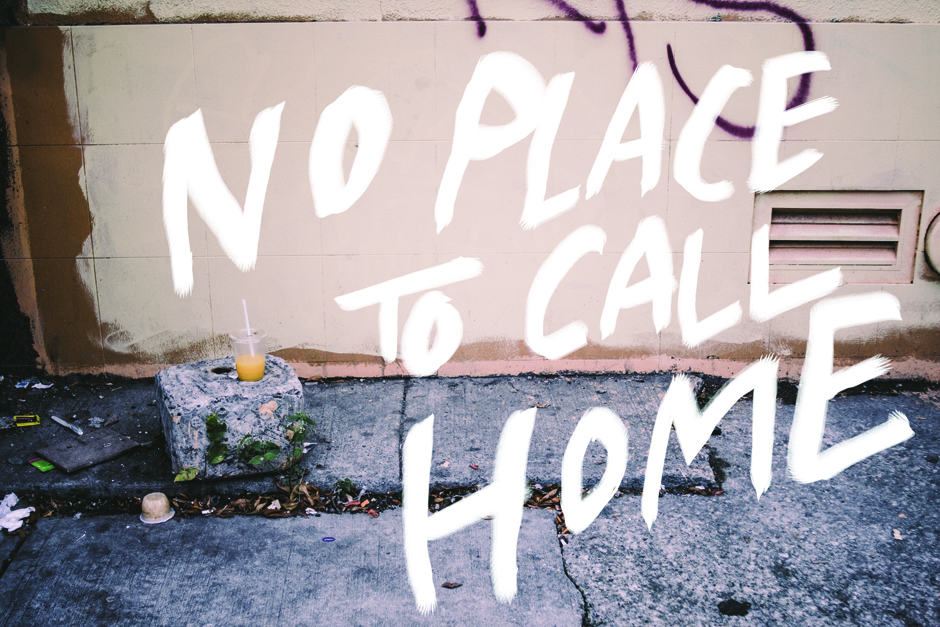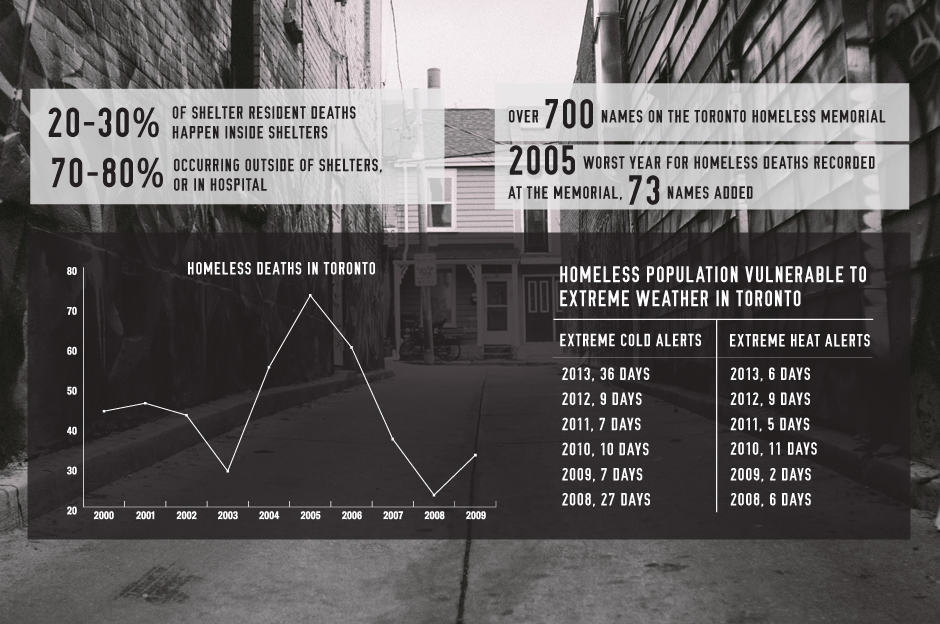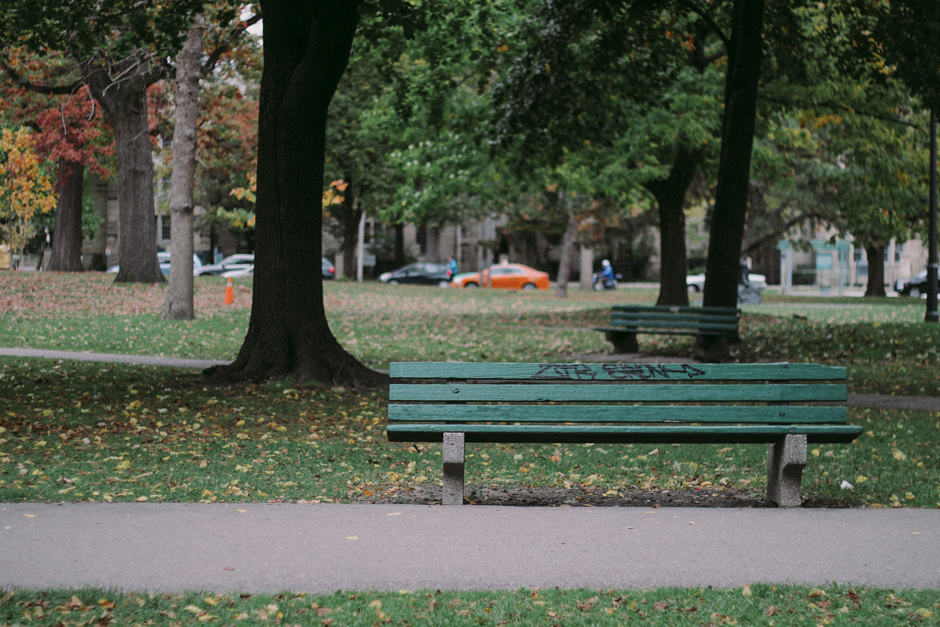Anthony Schofield walks south on Jarvis Street pointing out landmarks as he goes. The landmarks he describes are not buildings or intersections, but instead indications of homelessness.
“You’re looking at what’s residual of something that 10 years ago would have blown your mind,” he says, describing the state of homelessness in Toronto and the dramatic changes that have taken place. For him, these changes are very personal. Schofield was homeless for much of his life, and is now employed by various organizations to do outreach work and run educational programs.
According to Schofield, the gentrification of the city in the past two decades has pushed the homeless presence to the outskirts of the city’s neighbourhoods, and consequently, out of public awareness.
“In [Moss Park and St. James Park,] you would see dozens of people on benches, most of them lighting up, sleeping on benches,” he says. He remembers Toronto’s homeless population being much more visible, especially in very public spaces.
“15 years ago every doorway would have someone sleeping in it,” he adds.
LIVING WITHOUT CERTAINTY
Schofield’s life of homelessness began when he was 12 years old, when he started moving nightly, crashing on the couches of willing friends. The next decades of his life were spent cycling through various living conditions — shelters, others’ homes, and living on the street.
His experiences highlight the complicated typology of homelessness. According to the Canadian Homelessness Research Network, homelessness can take a variety of forms. “Unsheltered” describes the state of living in places not intended for human inhabitants, whereas, “provisionally accommodated” describes situations of tenuous, unstable housing — individuals in these circumstances may not be living on the streets, but lack a permanent residence.
The circumstances leading to homelessness are highly individual. For Schofield, it was a product of neighbourhood circumstances, early exposure to drug use and abuse, and the lack of a sense of empowerment. These problems, which he experienced nearly 30 years ago, are the same predicaments he witnesses today in his capacity as an outreach worker for various shelters and organizations dedicated to helping the homeless.
He points to the conditions of community housing as one important issue, saying, “If you give someone a crappy apartment, how do you think they feel? Definitely not empowered.”
In January 2014, Toronto Community Housing reported a capital repair backlog of $914,000,000. This deficit is approaching a critical level, and, without additional funding, buildings owned by the organization will fall deeper into disrepair.
HOMELESSNESS AND THE LAW
In the 1990’s two pieces of government legislation were enacted that have had a significant impact on the lives and visibility of homeless persons in the city. The first is the Ontario Mental Health Act (1990), a portion of which outlines the options available to police officers when they come into contact with individuals demonstrating symptoms of mental health issues.
The second is the Ontario Safe Streets Act (SSA), enacted in 1999. The latter was born from public concern regarding solicitation in public places, specifically the growing presence of “squeegee kids” in the 1990’s, who were ubiquitous on Toronto’s busiest street corners.
The SSA has been widely criticized. Issues include concerns about the definitions of “aggressive panhandling” which the act prohibits. The bill defines panhandling in an aggressive manner as “a manner that is likely to cause a reasonable person to be concerned for his or her safety or security,” a definition that critics argue is vague.
In 2011, a study published by York University and the University of Guelph recommended that the law be repealed, claiming that it is egregiously overused and contributes to the “criminalization of homelessness.” Perhaps one of the most impactful statistics in the report is a finding of a 2,000 per cent increased in the number of tickets issued to homeless people for panhandling between 2000 and 2010.
The SSA sets out specific circumstances in which aggressive panhandling may occur, including solicitation near a public transit stop or near a public transit vehicle, or solicitation near a vehicle or in a parking lot. Police can issue tickets in response to violations of the SSA, with fines ranging from $50 to $100.
The Mental Health Act, on the other hand, outlines the criteria police officers must follow when determining whether to take an individual displaying signs of mental illness into police custody for a psychiatric evaluation. These grounds include whether the individual is threatening or has attempted bodily harm to themselves or others, or whether the individual “has shown or is showing a lack of competence to care for himself or herself.”
In Schofield’s experience, the Mental Health Act has also had a profound experience on the work that outreach workers provide. “You can’t just call the police and have someone be taken into custody,” he says. Schofield claims that the act has limited the opportunities for intervention that outreach workers and police have to periods of crisis alone. The act does not accommodate for situations where an individual is demonstrating symptoms of mental illness — without an urgent need for intervention — and would benefit from a psychiatric evaluation upon being taken into custody.
“[If someone] hasn’t said they’re going to hurt me or herself I’m stuck — people have to say these things in order to be considered in crisis,” Schofield adds.
NECESSITIES FOR PROGRESS
Homelessness is a highly complex issue, with a network of underlying causes and complications. Consequently, solutions to homelessness are equally complicated. Inarguably, affordable and accessible housing, or a lack thereof, contributes to individuals’ abilities to secure stable shelter. According to the RBC Affordable Housing Index, the cost of owning a home in the Toronto area exceeds 50 per cent of an average household income; and the costs are only getting higher. The cost of condo ownership is also nearing the 30 per cent level. For low to moderate income households, these costs are simply unmanageable.
Some steps are being taken at the municipal level to offset the inaccessible costs of housing in the city. Currently, Toronto Community Housing provides housing to around 58,500 low-to moderate income households. However, while they offer both subsidized rent and “affordable” rent rates, the latter is often set at or just slightly below market value, making these options unattainable for many individuals. With the average cost of rent increasing annually in the city, considering more affordable options for one of the city’s most vulnerable populations is essential.
There is also a distinct need for additional emergency shelters. “There aren’t enough beds,” says Schofield. Currently the city has a 3,800-bed shelter system, which simply cannot accommodate the number of individuals in need of shelter on a nightly basis.
Even when space is available, encouraging individuals to take shelter is challenging. “You can’t make people go inside,” explains Schofield. “I can come by, tell them who I’m working for, offer them an option. But if they say no or tell me to leave all I can do is leave a bottle of water and a card,” he adds.
While reactionary measures remain essential to ensure individual safety in the short-term and provide for housing infrastructure in the future, understanding and addressing the individual factors that place people at risk of homelessness is crucial.
It’s a complicated issue, but for Schofield, there’s one universal element: “For most people, this isn’t a choice,” he stresses, adding, “There are any number or reasons why someone ends up on the streets — addiction, family abuse, individual trauma — but it’s rarely a choice.”
With files from Covenant House, the Canadian Homelessness Research Network, Homelessness Services Toronto, the Ontario Mental Health Act, The Ontario Safe Streets Act, Toronto Public Health, The Toronto Star and the RBC Housing Affordability Report.






